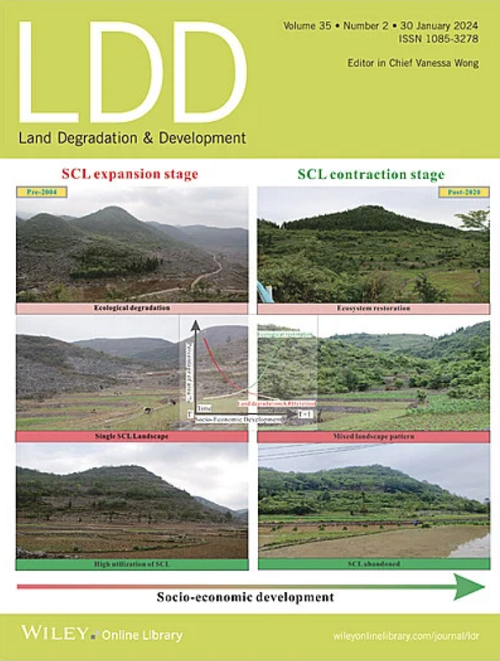利用δ13C区分不同碳水平下侵蚀对原位和非原位土壤有机碳的影响
IF 3.7
2区 农林科学
Q2 ENVIRONMENTAL SCIENCES
引用次数: 0
摘要
与土壤侵蚀有关的二氧化碳排放的影响是一个紧迫的全球问题。然而,缺乏可靠的方法阻碍了对土壤有机碳(SOC)命运的全面了解。这包括它的再分配、矿化和影响这些过程的因素。因此,在估算侵蚀地区的二氧化碳排放量时出现了不一致。本研究考察了雨季侵蚀坡面。我们采用δ13C同位素示踪法量化了侵蚀引起的有机碳再分配。此外,我们还确定了有机碳矿化基质的来源及其驱动因素。我们的目标是描述侵蚀对不同土壤有机碳水平斜坡二氧化碳排放的不同原位和非原位影响。结果表明,非原位有机碳分别有1.4% ~ 2.9%和2.9% ~ 5.1%在侵蚀和沉积部位重新分布,对应于中度至重度侵蚀。在侵蚀引起的总有机碳矿化中,原位和非原位有机碳基质分别占坡面总有机碳的0.7% ~ 6.3%和2.3% ~ 2.8%。侵蚀样地土壤有机碳矿化率为0.6% ~ 5.7%,迁地土壤有机碳矿化率为1.8% ~ 2.3%,沉积样地土壤有机碳矿化率为0.8% ~ 7.1%,3.1% ~ 4.0%。值得注意的是,土壤有机碳(SOC)含量和土壤含水量(SWC)对矿化表现出截然不同的影响:SOC含量对原位有机碳矿化产生负向影响,而SWC对非原位有机碳矿化产生正向影响。其中,有机碳含量对原位有机碳的负向作用更强,而SWC对非原位有机碳矿化的正向作用更显著。基于这些对侵蚀过程中原位和非原位有机碳动态的认识,我们建议对侵蚀斜坡的二氧化碳排放进行评估,同时考虑原位和非原位效应以及有机碳水平。此外,提高土壤抗侵蚀能力和缓冲能力的措施可以减少侵蚀导致的有机碳损失,并可能减少侵蚀斜坡的二氧化碳排放,如优化灌溉、作物秸秆掺入和施用有机肥。本文章由计算机程序翻译,如有差异,请以英文原文为准。
Distinguishing Erosion Effects on In‐Situ and Ex‐Situ Soil Organic Carbon at Varying Carbon Levels Using δ13C
The effect of CO2 emissions linked to soil erosion is a pressing global concern. However, the lack of robust methodologies has hindered a comprehensive understanding of the fate of soil organic carbon (SOC). This includes its redistribution, mineralization, and the factors influencing these processes. As a result, inconsistencies have emerged in estimating CO2 emissions from eroded areas. This study investigated eroded slopes during the rainy season. We employed δ13 C isotopic tracing to quantify SOC redistribution caused by erosion. Additionally, we also identified the sources of SOC mineralization substrates and their driving factors. Our goal was to delineate the distinct in‐situ and ex‐situ effects of erosion on CO2 emissions from slopes with varying SOC levels. The results revealed that 1.4%–2.9% and 2.9%–5.1% of ex‐situ SOC were redistributed across erosion and sedimentary sites, corresponding to moderate to severe erosion. Of the total SOC mineralization induced by erosion, in‐situ and ex‐situ SOC substrates accounted for 0.7%–6.3% and 2.3%–2.8% of total slope SOC, respectively. In erosion sites, the mineralization ratios of in‐situ and ex‐situ SOC were 0.6%–5.7% and 1.8%–2.3%, while in sedimentary sites, these ratios were 0.8%–7.1% and 3.1%–4.0% respectively. Notably, SOC content and soil water content (SWC) exhibited contrasting effects on mineralization: SOC content negatively influenced in‐situ SOC mineralization, whereas SWC positively affected ex‐situ SOC mineralization. Specifically, SOC content exerted a stronger negative effect on in‐situ SOC, while SWC played a more significant positive role in ex‐situ SOC mineralization. Based on these insights into the dynamics of in‐situ and ex‐situ SOC during erosion, we recommend that CO2 emission assessments from eroded slopes account for both in‐situ and ex‐situ effects, as well as SOC levels. Furthermore, measures to enhance soil erosion resistance and buffering capacity could reduce erosion‐driven SOC loss and potentially mitigate CO2 emissions from eroded slopes, such as optimized irrigation, crop residue incorporation, and organic fertilizer application.
求助全文
通过发布文献求助,成功后即可免费获取论文全文。
去求助
来源期刊

Land Degradation & Development
农林科学-环境科学
CiteScore
7.70
自引率
8.50%
发文量
379
审稿时长
5.5 months
期刊介绍:
Land Degradation & Development is an international journal which seeks to promote rational study of the recognition, monitoring, control and rehabilitation of degradation in terrestrial environments. The journal focuses on:
- what land degradation is;
- what causes land degradation;
- the impacts of land degradation
- the scale of land degradation;
- the history, current status or future trends of land degradation;
- avoidance, mitigation and control of land degradation;
- remedial actions to rehabilitate or restore degraded land;
- sustainable land management.
 求助内容:
求助内容: 应助结果提醒方式:
应助结果提醒方式:


